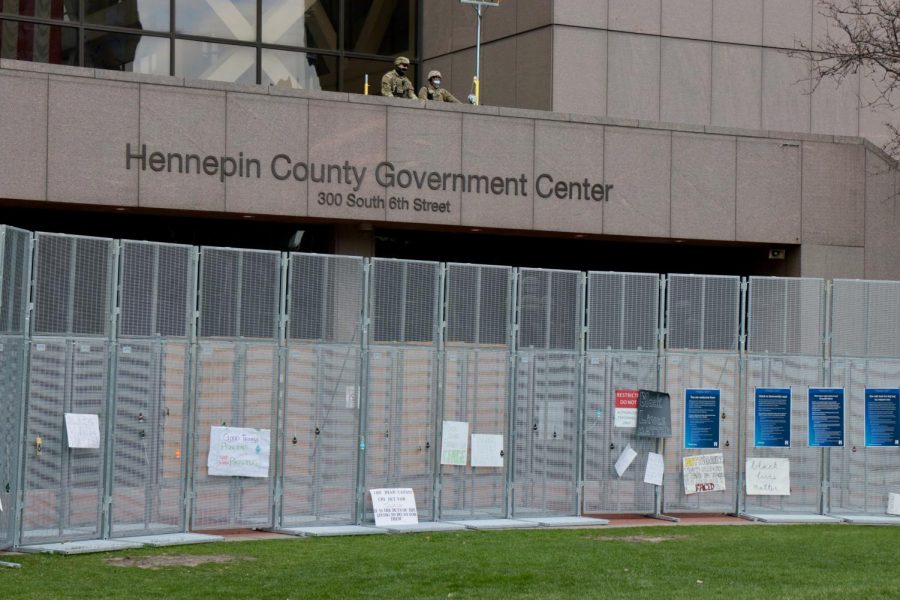The evidence is in, the arguments have been presented — it is now up for the jury to decide.
The murder trial of former Minneapolis police officer Derek Chauvin is coming to a close as the jury received instructions and closing arguments Monday. Next, the jury is sequestered and determines the verdict and, if they decide to convict, what charges to apply to Chauvin for killing George Floyd.
The Daily has offered daily briefings throughout trial proceedings.
Chauvin is charged with second-degree manslaughter and second- and third-degree murder. In order for Chauvin to be found guilty on any account, the jury needs to come to a unanimous decision. Even if he is convicted on all three accounts, he would only be sentenced on the most serious offense.
Here’s what that could mean for Chauvin
Below are the Minnesota sentencing guidelines, depicting how long someone can be sentenced per crime committed and their criminal history.
Here’s a quick little explanation of Minnesota’s sentencing guidelines, which can help Minnesotans and out-of-staters alike understand what Derek Chauvin would face if found guilty — as well as understanding the charge Kim Potter now faces. First, this is the grid. pic.twitter.com/jHVgiyqlE7
— Lou Raguse (@LouRaguse) April 15, 2021
If Chauvin is convicted, there will be a list of questions for the jury to reply “yes” or “no” to that define any aggravating factors, circumstances that can make a case particularly more unpardonable than a case with the same charge.
Former Hennepin County chief public defender Mary Moriarty said some of these questions are: Were there minors present? How many minors were present? Was George Floyd handcuffed? Was he in a particularly vulnerable position?
These questions indicate aggravating factors in the case, and if the jury responds with “yes” to any of these questions, the judge can grant an “upward departure,” adding time to Chauvin’s sentence. The amount of time added is up to the judge.
Judge Peter Cahill said he will allow both the defense and the prosecution to write memos arguing what sentence they believe is appropriate.
Second-degree murder
Second-degree murder is interpreted as the defendant having been in the process of committing a felony — in this case, assaulting Floyd — that contributed substantially to the death of a person. In this case, the state is arguing that Chauvin committed third-degree assault against Floyd. There does not have to be intent.
Because Chauvin does not have a criminal record, the average sentence for second-degree murder is 150 months — about 12 and a half years. The maximum sentence is 40 years if Cahill granted an upward departure.
Third-degree murder
For Chauvin to be convicted of third-degree murder, the jury needs to find that he acted with a “depraved mind,” meaning he acted with reckless disregard for Floyd’s life. The state does not have to prove intent or that Chauvin committed assault against Floyd. This is the highest negligence charge possible, according to Moriarty.
The average sentence for third-degree murder is 12 and a half years, but the judge can add time for aggravating factors. The maximum sentence is 25 years.
Former Minneapolis police officer Mohamed Noor was convicted of third-degree murder and second-degree manslaughter in 2019 and was sentenced to over 12 years for the offense. His case is up for appeal in June, which could impact Chauvin’s sentence if he is also charged with third-degree murder.
“I’m sure that the judge will be thinking about … the differences between Noor and Chauvin’s behavior when he is deciding an appropriate sentence,” Moriarty said.
The instructions for third-degree murder in Chauvin’s case are based on the Noor ruling, so if it is overturned in June, then Chauvin could appeal if convicted for third-degree murder, MPR News reports.
Second-degree manslaughter
For Chauvin to be convicted of second-degree manslaughter, the jury needs to find him guilty of having taken a conscious risk with Floyd’s life that resulted in his death. The sentence can be as high as 10 years in prison or a fine of no more than $20,000.
Prosecution’s case
On Monday, Chauvin waived the right for a jury to determine whether there were aggravating factors after the state filed a notice to seek an aggravated sentence. Now Cahill must decide.
The state called 38 witnesses, arguing that Chauvin’s knee on Floyd’s neck substantially contributed to his death and Chauvin’s use of force was not reasonable and violated Minneapolis Police Department policy.
The state brought forward two medical examiners, a cardiologist and a pulmonologist to stack up the medical evidence that Floyd’s heart and lungs then stopped because of Chauvin’s actions.
Dr. Martin Tobin, a pulmonologist, said that low oxygen caused Floyd’s heart to stop, killing him. He testified the prone position, the positioning of Floyd’s handcuffs and the positioning of Chauvin’s knees on Floyd’s neck and back all played a key role in restricting his oxygen.
He estimated that Chauvin continued to kneel on Floyd’s neck for three minutes and two seconds after there was no oxygen left in his body.
Tobin also disproved the defense’s argument that the carbon monoxide from the squad car built up in Floyd’s lungs and contributed to his death. Since Floyd’s oxygen saturation was 98%, the maximum amount of carbon monoxide that could have been in his system was 2%, Tobin said.
The state has the burden of proving that Chauvin’s use of force was excessive and did not fit what a “reasonable police officer” would do.
Multiple use-of-force experts and Minneapolis police officers, including chief of police Medaria Arradondo, testified that Chauvin’s use of force violated MPD policy and training.
“To continue to apply that level of force to a person proned out, handcuffed behind their back … that in no way, shape or form is anything [according to] policy,” Arradondo said. “It is not part of our training and it certainly is not a part of our ethics or values.”
Seth Stoughton, an associate professor of criminal law at the University of South Carolina Law School and use-of-force expert, walked the jury through a video of Chauvin’s restraint. He pointed out various moments when the officers should have put Floyd into the side recovery position and applied first aid, most notably when former officer Thomas Lane checked for Floyd’s pulse and did not find one.
Now this clip. Stoughton says two things stand out: Floyd says he can’t breathe, an indicator of positional asphyxia. Also, Stoughton says drug or alcohol use can exacerbate positional asphyxia. Officers here discuss drug or alcohol use. pic.twitter.com/0yNV2RX614
— Rochelle Olson (@rochelleolson) April 12, 2021
Defense’s case
The defense rested its case after bringing seven witnesses to the stand over the course of two days without the testimony of Chauvin.
Eric Nelson, Chauvin’s attorney, focused his argument around Floyd’s prior health conditions and argued that Chauvin’s use of force was reasonable given his training at the Minneapolis Police Department and the stressful nature of the scene on May 25, 2020.
Nelson’s witnesses included a use-of-force expert, the MPD’s emergency medical response training officer, an eyewitness, a former medical examiner and current and former police officers.
Dr. David Fowler, Maryland’s former chief medical examiner, contradicted the two autopsies done on Floyd, claiming that his death was “undetermined.” Both Hennepin County medical examiners determined that the cause of death was homicide.
“I actually was expecting him to say it was accidental,” Moriarty said. “And so that puts the defense in the position of arguing against reasonable doubt, which isn’t a particularly strong position.”
Fowler is currently being sued for the wrongful death and civil rights violations of a Black teenager in police custody.
The use-of-force witness, Barry Brodd, was the first witness to claim that Chauvin’s use of the controversial prone position was justified, contradicting the prosecution’s multiple witnesses that said it is lethal and played a significant factor in Floyd’s death.
“I don’t think [Brodd] really helped the defense case at all. Partly because his testimony was directly contradictory to all of the officers from the Minneapolis police department, including the chief,” Moriarty said. “It just didn’t make much sense, how can you say that entire nine and a half minutes was not a use of force?”














Ted Zilla
Apr 20, 2021 at 6:14 pm
Where are the assistant murderers?
The other police that were with him?